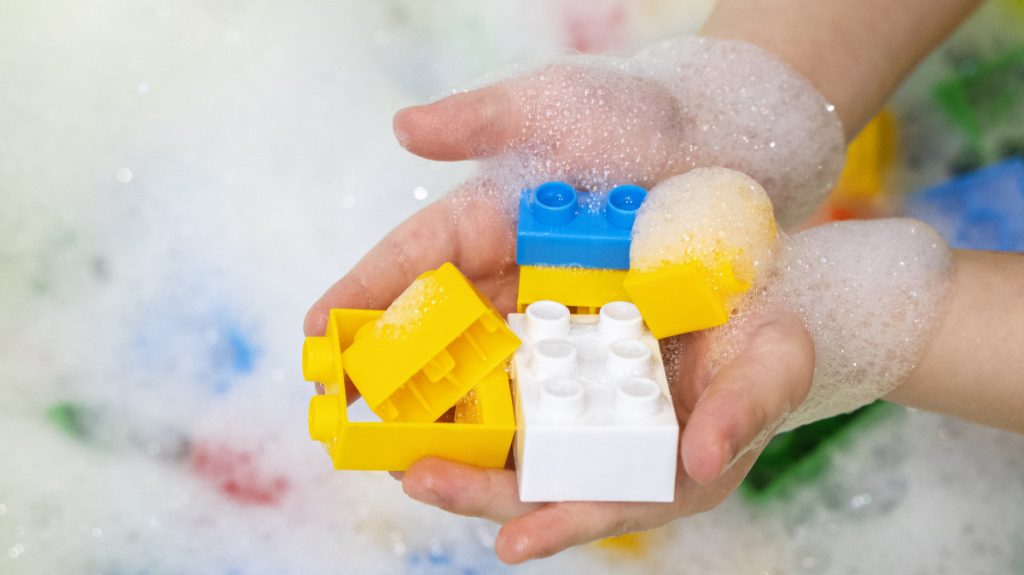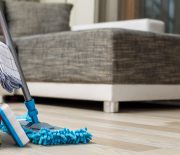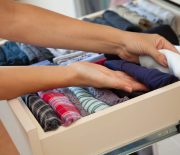Last update: 5 months ago

Ah, baby toys — they get around, don’t they? One minute, they’re happily bouncing along in the pram, and the next, they’re rolling under the couch or, worst of all, taking a quick dip in the toilet. Then, without a second thought, they’re back in your little one’s mouth. Lovely, right? But beyond the mess and mayhem, there’s actually good reason to give those toys a decent clean now and then. While Australia may be home to some amazing wildlife, we’d all rather avoid the less appealing kind of bugs — the ones lurking on toys.
Keeping toys clean and germ-free not only helps fend off the sniffles but also tackles some serious health risks. Continue reading for practical tips to keep your baby’s toys fresh.
Importance of cleaning baby toys
Baby toys are more than just fun distractions. They’re loyal sidekicks in your little one’s daily adventures. But while toys get all that love, they also go through drooling, diaper mishaps, and sticky spills—which can quickly turn them into hotspots for germs and bacteria. The following reasons make regular cleaning so important:
- Stops germs in their tracks – Routine cleaning gets rid of bacteria and viruses that cling to toys, keeping your baby safer from potential illnesses.
- Keeps allergens at bay – Dust mites and allergens love hiding in plush toys and little crevices. Regular washing and drying keep these allergens under control.
- Maintains toy safety and durability – Clean toys tend to last longer. By keeping grime away, you’re actually protecting the toy’s material and your investment.
- Safe exploration – Babies and toddlers use all their senses to explore—especially taste! Clean toys let them explore safely.
- Supports overall health – Having a clean play area means your baby and friends can have fun worry-free.
Important! Don’t underestimate the power of clean hands! Minimise bacteria spread by washing your hands.
How often should you clean and disinfect baby toys
You can make a big difference by setting a routine for toy cleaning, no matter what your schedule is. Here’s a quick guide to keeping various types of toys and baby accessories clean:
- Plush or soft toys – Machine-wash weekly, especially if these toys join your baby in bed. Spot-clean any visible stains or grime.
- Hard plastic toys – Every week, they need to be cleaned and disinfected.
- Baby toys (frequently mouthed) – Clean and sanitise these toys every one to two days since they’re most likely to end up in your baby’s mouth.
- Electronic toys – Wipe these down weekly to remove dust and bacteria.
After playdates, disinfect all toys and accessories that were shared, as germs can spread easily through shared toys. Besides cribs, sanitise mini cribs, rocking chairs, toy storage, diaper changing tables, crib sheets, etc.
And when life gets a little too busy, consider hiring cleaning experts to tackle your home. You just enjoy the time with your baby.
How to clean baby toys the right way
Cleaning baby toys doesn’t have to be complicated. Getting it right does mean knowing a bit about what each toy needs. While some toys can handle a good soak, others may only need a quick wipe or even a gentle brush-off. Keep your little one’s playthings safe with these tips on how to clean toys – from the ones you can wash to the ones you have to take extra care of.
How to clean plastic toys
Keeping plastic toys clean can feel like a never-ending job for parents. Actually, it’s worth it to keep germs at bay. Find out how to clean baby toys effectively so they stay safe and fresh.
- Check for dishwasher safety – Look for a dishwasher-safe label on the toy.
- Prep for washing – Remove batteries or electronic parts of toys.
- Dishwasher method (for dishwasher-safe toys) – Place the toys on the top rack of your dishwasher. Use a gentle dishwasher detergent. Run on a warm cycle with a drying setting.
- Hand washing method – For toys that aren’t dishwasher-safe, mix warm water with a bit of dish soap to create a soapy solution. Use a cloth or toothbrush to scrub the toys. Pay special attention to tiny crevices. Use diluted bleach (1 tablespoon bleach per gallon of water) for stubborn grime. Just remember to rinse the toys thoroughly afterwards.
- Using vinegar for cleaning – Dip a cloth in white vinegar for a natural approach. Wring it out well, and wipe the toy down. Vinegar is great for removing sticky buildup. It serves as a general cleaner with the ability to kill some germs.
- Drying – Air dry the toys or wipe them down. Try a low heat setting on your hairdryer for any tricky spots.
- Regular maintenance – Use disinfecting wipes to clean plastic toys. Do it especially after playdates or if your child has been sick. This keeps them fresh and ready for the next adventure.
How to clean plush or soft toys
Your child’s favourite plush toys go wherever they go, collecting dirt and the occasional sticky spot. These well-loved friends can be tricky to keep fresh and soft, but here’s a detailed explanation of how to clean plush toys.
- Check the care label – Start by reading the care instructions. Some toys can handle a machine wash, while others need a gentler approach.
- Quick spot cleaning – If you want to know how to clean stuffed toys, quick spot cleaning is a great start. Use warm, soapy water and a soft cloth to clean up small messes. Then, gently scrub the spot. Let it air dry.
- Machine washing for a deep clean – If the toy is machine washable, place it in a pillowcase or mesh laundry bag to protect it. Wash on a gentle, cold-water cycle with mild detergent. Let it air dry or use a low setting in the dryer if it’s okay.
- Hand washing for extra care – Fill a basin with cold water and a bit of mild detergent. Submerge the toy, gently swish it around, and rinse thoroughly. Press out excess water (avoid wringing) and reshape the toy before air drying.
- Handling delicate features – For toys with electronic parts or delicate details, stick to spot cleaning.
- Freshen up – Place the toy in a sealed bag in the freezer for 24 hours to tackle dust mites or allergens. Later, clean as usual.
Add those well-loved plush toys to your deep cleaning routine to tackle built-up dust, dirt, and allergens. Give them more frequent quick cleanings to keep them soft, bright, and ready for countless snuggles.
Important: Plush toys should be completely dry before use to prevent mould and mildew.
How to clean wooden toys
Cleaning wooden toys takes a gentle touch. Wood absorbs moisture, unlike plastic, so skip soaking and harsh cleaners. From teethers to toy trucks, here’s how to keep wooden toys fresh and ready for fun.
- Spot clean regularly – Use a cloth that’s just slightly damp with water. Add a bit of mild dish soap if needed. Gently wipe away dirt and sticky spots. No need for heavy scrubbing!
- Dry thoroughly – Let the toys air dry completely after cleaning. Avoid direct sunlight to prevent warping or fading.
- Disinfect naturally – Prepare a mixture of diluted white vinegar or apple cider vinegar in a spray bottle. Lightly spritz the toy. Then, wipe it down with a clean, dry cloth. This gentle, natural disinfectant keeps the wood safe.
- For stubborn dirt – For tough dirt, mix baking soda with water to create a paste. Gently scrub the problem spots with a damp cloth.
- Avoid excessive water – Never soak wooden toys. Wood can swell or crack if there’s too much moisture. Stick with a damp cloth rather than a wet one to avoid damage.
- Wax or oil finish – Seal the wood with beeswax or vegetable oil to prevent it from drying out. Apply lightly with a cloth, then buff for a smooth finish.
- Check for damage – Regularly inspect for splinters or sharp edges. Sand any rough spots to keep them safe and smooth.
When storing toys in the garage, keep them in sealed, waterproof containers. It’ll keep them safe from dust, moisture, and uninvited guests.
How to clean electronic or battery-operated toys
Electronic or battery-operated toys bring all the fun but can be a bit trickier to clean. These toys require a gentler touch to keep them safe and functional. Here’s how to clean baby toys that can’t be washed:
- Remove batteries first – Take out the batteries before cleaning to prevent damage. Close the battery compartment securely.
- Wipe down carefully – Dampen a cloth with a mix of water and mild soap (but not dripping wet). Gently wipe the surface. Avoid any openings or seams to keep moisture out.
- Use disinfectant wipes – Wipe down non-porous surfaces gently with a disinfectant wipe. Avoid any seams or openings to keep moisture from reaching the electronic parts.
- Use cotton swabs for small areas – For those tiny nooks, a cotton swab lightly dipped in the cleaning solution works wonders. Be careful to avoid any vents or electronic parts.
- Air dry completely – Let the toy air dry fully before putting the batteries back in. This step helps avoid any trapped moisture that could harm the toy’s inner components.
- Regular maintenance – Give these toys a quick wipe-down every now and then, especially if they’re handled often. It keeps them fresh and working for your child’s next adventure.
Include toys in your home declutter checklist by checking for any leaks, particularly in older toys that may have seen better days. This simple step can help prevent messes and keep playtime safe for your little ones.
Assess which toys your child still plays with and consider donating or storing those that are no longer loved, creating a more organised and enjoyable space.
How to clean bath toys
Cleaning bath toys might seem easy, but many parents know it can be a struggle. Water can hide inside these toys, turning them into potential hotspots for mould and dirt. Follow this simple guide on how to clean bath toys to keep your child’s playthings sparkling clean and safe!
- Empty and rinse – After each bath, squeeze out all the water from any toys that can hold it. Rinse them under running hot water to flush away soap residue.
- Soak in a vinegar solution – Once a week, fill a basin with one gallon of water and half a cup of white vinegar. Soak the toys for about an hour, as vinegar is a natural disinfectant that helps eliminate mould and mildew.
- Use diluted bleach – For a deeper clean, using diluted bleach is a great place to start for cleaning bathtub toys. When tackling how to clean bath toys with mould inside, remember that a 1:10 ratio of bleach to water is perfect for thorough disinfection.
- Scrub away grime – For toys that show visible dirt or mould, use a toothbrush to scrub gently, paying special attention to crevices where mould likes to hide.
- Rinse thoroughly – After soaking and scrubbing, rinse the toys under warm water to remove any vinegar smell and residue.
- Air dry completely – Let the toys air dry in a well-ventilated area. If they have holes, squeeze them during the drying process to expel any trapped water.
- Seal holes – To prevent water from getting inside, consider sealing the holes in bath toys with hot glue. This is optional but can help maintain the cleanliness and longevity of the toys.
- Regular checks – Frequently inspect bath toys for signs of mould. If you come across any that are beyond cleaning, it’s best to replace them to keep your child’s playtime healthy.
How to clean baby toys before first use
Give your baby’s toys a quick wash before they’re used for the first time to clear away any factory dust, residues, or hidden dirt.
- For plastic or non-electronic toys – Wash with warm, soapy water or use a mild child-safe disinfectant. Then rinse thoroughly. Let them air dry.
- Soft toys can often be machine-washed – Just pop them in a mesh laundry bag. Use a gentle cycle, and wash with baby-friendly detergent.
- For more delicate or surface-clean-only toys – Wipe gently with a damp cloth or a disinfectant wipe. Avoid any electrical components if present.
Always check and follow the manufacturer’s care instructions and ensure everything is completely dry before letting your baby enjoy it!
Sanitising and disinfecting
Keeping toys safe for playtime means understanding the difference between sanitising and disinfecting. While both reduce germs, they’re each suited to different situations.
Sanitising is a lighter process that reduces bacteria to safer levels. This is great for toys your child plays with every day. It’s especially effective for those made of plastic or fabric that require regular, gentle cleaning.
Disinfecting goes a step further. It kills a broader range of germs, including viruses. The method is better for tougher materials, like hard plastics or rubber that can withstand stronger cleaners. It’s also perfect for toys shared between kids or after playdates, especially when it’s cold and flu season.
During illness outbreaks, disinfecting becomes very important. Disinfect frequently handled toys, like electronic gadgets and teething rings, after each play session to keep your family healthy.
Takeaways
- Regular cleaning just not only prevents illness. It also keeps toys safe for exploration and extends their life.
- Different types of toys require specific cleaning methods so they’re properly sanitised without damage.
- It’s also important to differentiate sanitising versus disinfection. Sanitising reduces germs during regular cleaning while disinfecting kills a broader range of germs. This makes it ideal for shared or frequently handled toys, especially during illness outbreaks.
Keep your little one’s playthings germ-free. We’re here to help!
Let us handle the mess. Book our cleaning services today!








